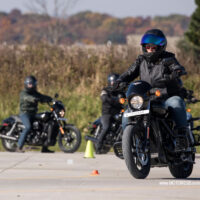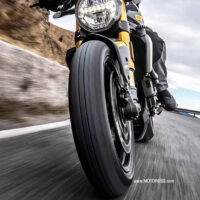Last Update: 5 November 2022
Last Update: 28 October, 2022

Riding your motorcycle in fog or foggy conditions represents a huge challenge even for motorists on four wheels. And fog can occur unexpectedly around the next corner or when road elevations increase or decrease. Furthermore, fog conditions can be amplified with rain and accompanying darkness.
Preparation and knowing what to expect in foggy situations is crucial to your safe riding and to arriving at your final destination.
Six Major Challenges To Prepare For
It really goes without saying- in dense fog conditions it is best not to ride – it is a high-risk condition. So if possible, delay your ride until fog clears. However, that’s not always possible. So if you’re caught in fog or in a foggy situation these are the challenges you’ll need to prepare for:
|
|
|
|
|
|
Strategies For Riding In Fog
- Call ahead to your destination and alert someone as to your route and expected time of arrival.
- Make sure you have a full tank of gas before departing.
- Take the most familiar route to your destination.
- Instal a Pinlock Lense on your face shield or apply an anti-fogging agent on your visor or goggles/eyewear.
- Ensure your mirrors are clean. Even the slightest debris will effect vision.
- Double check strapped on luggage/cargo to ensure tightly secured.
- Wear a reflective high visibility vest.
- Use your regular headlamp mode. The high beam reflects off moisture droplets in the fog, which will make it near impossible to see.
- Pay full attention to your riding- lane position, speed, etc.
- Reduce speed and slow down. Riding at a speed which suits the conditions and allows you more time to react. And in fog conditions, you may be going faster than you think. If so, reduce speed gradually. Remember, you want time to react.
- Remain calm, patient and relaxed. Sudden movements and panic will cost you.
- Avoid passing, changing lanes and crossing traffic.
- Use the pavement markings on shoulder or curbside of your lane to guide you. Using the centre line is not the best as when headlamps from oncoming vehicles approach, they tend to “glare out” the centreline in such conditions.
- Increase your standard 2-3 second following distance. You will need an extra distance to react and brake safely.
- Watch for any electronically operated warning signs.
- Keep looking as far ahead as possible.
- Monitor your mirrors for fast approaching vehicles from behind and, if necessary, prepare to take evasive action.
- If another vehicle is following too close, tap your rear brake pedal enough to flash your rear brake light – or turn on your hazard lights- if you have them.
- Avoid sudden inputs to the brakes or steering. Use engine braking as much as possible but ensure you partner this with an illuminated brake light to indicate you are slowing.
- Follow the tail lights of another vehicle, at a safe distance and speed, to reduce any spatial disorientation.
- If forced to stop, either by the fog becoming too dense or a mechanical problem, move yourself and your bike well off the road.
- If the fog is too dense to ride, pull completely off the road and try to position your vehicle in a safe parking area. Turn on your hazard lights if you have them. Move away from your bike, off the road, a safe distance away from your bike.
Four Don’ts When Riding in Fog
- Don’t stop on the travelled part of the road. Even if you run out of fuel, or have a mechanical issue, move yourself to the road side immediately. You could be hit from behind.
- Don’t speed up suddenly, even if the fog seems to be clearing. You could find yourself suddenly back in fog around the next corner.
- Don’t speed up to pass a vehicle moving slowly, drop back and create space – it’s too risky.
- Don’t speed up to get away from a vehicle that is following too closely. Instead, signal, move to the shoulder or off the road and if needed, allow the following vehicle to pass.
READ MORE ABOUT:
| How to Ride in The rain | How to Ride in Heavy Rain |




